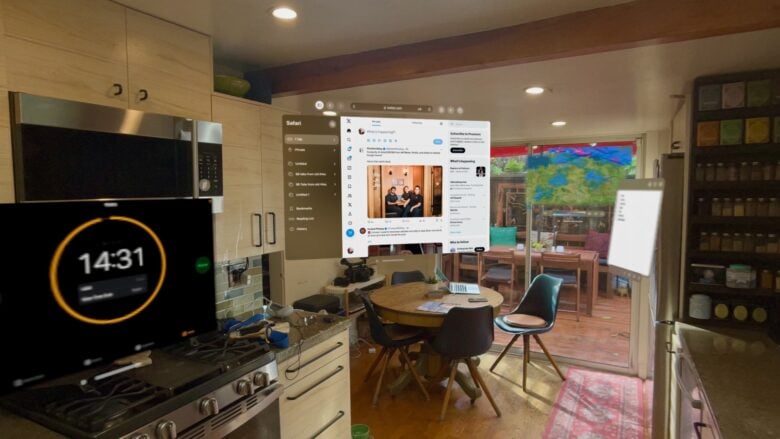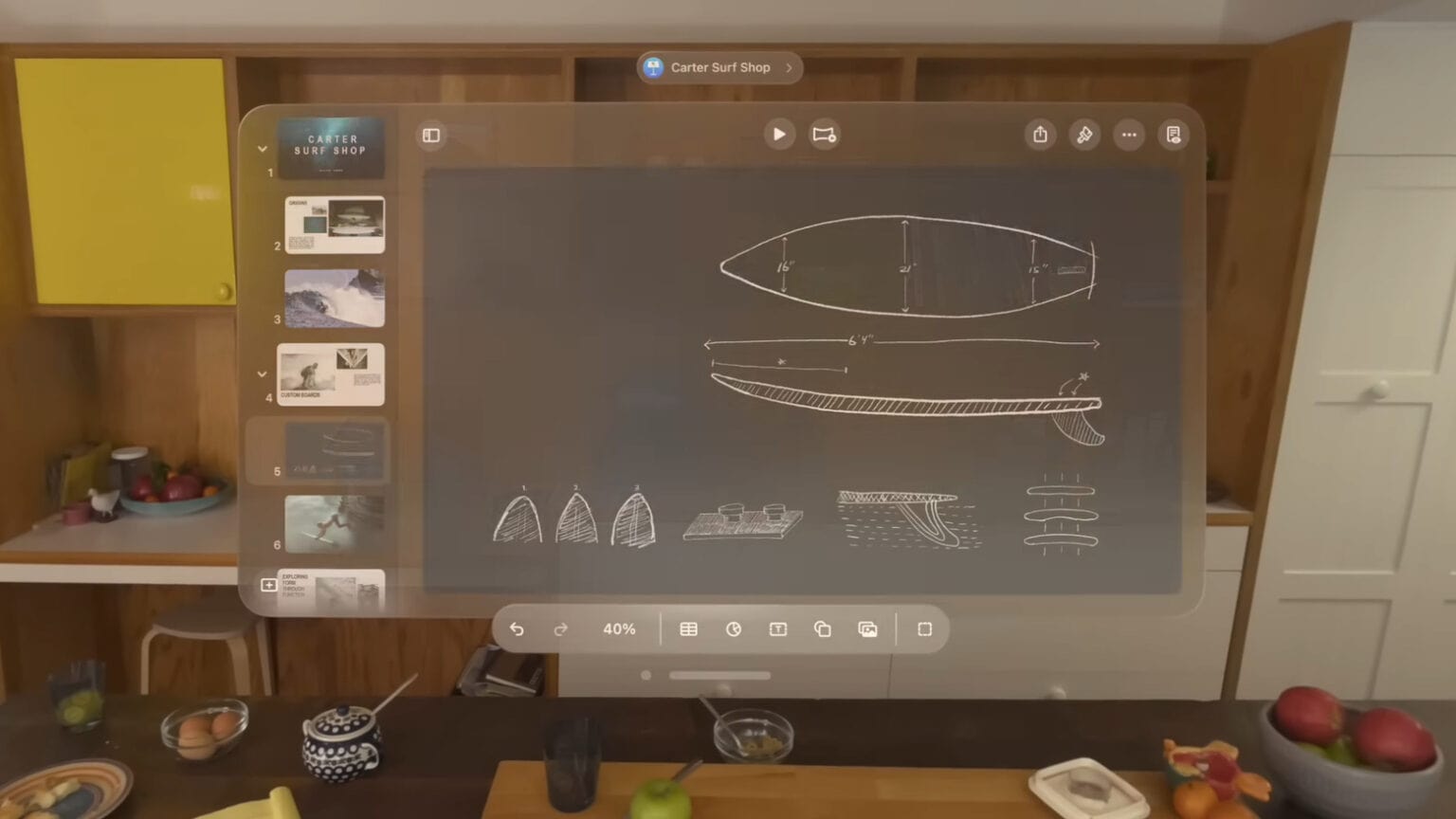Vision Pro is years ahead of its time. Apple’s AR headset lets us see today what using an average computer a decade in the future will be like.
In 2034, being surrounded by physical screens will seem charmingly obsolete. Virtual displays of any size generated by an AR headset from Apple (or its rivals) will take the place of displays connected to our computers, phones, watches, etc. And that’s only the start.
You can experience the coming revolution now because Vision Pro is another example of Apple giving us a glimpse of the future.
Apple Vision will replace Mac, iPhone, iPad and Apple Watch
Before I used Vision Pro, I wondered why Apple CEO Tim Cook didn’t put the headset on hold for another few years until the hardware seemed less primitive. Now, having strapped one on, I understand.
Forget the physical device — the software is amazing. visionOS takes the user interfaces we’re already accustomed to from our Macs, iPads, etc., and expands them to a new class of devices.
Vision Pro shows us that the computers we have now have progressed about as far as they can. What we currently use are highly improved versions of devices from the 1990s, but there isn’t much room for further enhancement. That’s why we find new MacBook and iPhone versions kind of boring. And why the Mac mini hasn’t been redesigned in many years.
It’s time to replace them with a whole new type of computer. A much better option. Vision Pro is the first of these. It’s crude and limited compared to what’s coming, but future versions will change the world.
People keep asking Apple for innovation. Here it is.
Vision Pro is, well, a vision of the future

Photo: Leander Kahney/Cult of Mac
I’ll explain by example. On a typical morning in 2034, you’ll begin your day by putting on your Vision AR glasses. These won’t be huge and clumsy — the headset will be much closer to a pair of today’s prescription glasses. They might need to be wired to a box that rides in your pocket, but let’s not get distracted by details.
While you drink coffee, you’ll do the same things you do now on your iPhone: Check social media, maybe scan a few news sites. These apps are easier to see, and you’re not hunched over your phone, because you’re using your Vision glasses instead. But they don’t interfere with seeing your spouse and kids across the table.
The future of work in Vision Pro
You take your Apple car to the office, and then it’s time to get down to business: Open the applications you need to do your job. These work essentially the same as the ones you use today, only the app windows look larger. They’re easier to see and to work with because they are projected in front of your eyes by your Vision AR glasses, not restricted to screens that sit on your desk.
Even in 2034, it’s possible you still use a physical keyboard. This bit of 19th-century tech has proved remarkably long-lived because it’s a better option than so many of the alternatives. Possibly you prefer visionOS‘s virtual, floating keyboard instead, or use your voice to enter text. (It really is the fastest way to “type” on Vision Pro.)
When you go to a meeting, everyone can see each other but also easily look at the presentation on a virtual screen floating in front of them, thanks to their AR glasses. Not everyone is in the same room, but that’s irrelevant, thanks to augmented reality.
After work, it’s time for virtual movie night
At the end of the day, you and your family watch a movie together. Each of you wears your own pair of Vision glasses, but you don’t feel isolated. You can still see everyone, but you can also see a giant screen.
Movie night happens after you help your kids with their homework by sharing a learning application’s windows.
Notice that none of this sounds fundamentally different from what we do now. It’s just easier. visionOS doesn’t throw out the lifetime of computing experience we’ve built up — it builds on it. And our living and workspaces aren’t crammed full of expensive, redundant screens.
Start thinking outside the box
But let’s move past “what we have now but better.” It’s time to think of ways that future versions of Apple Vision Pro can offer fundamental lifestyle changes.
Suppose you live in a tiny apartment with a stunning view of the trash dumpsters. Simply put on your AR glasses to transform your view to one overlooking Central Park. Or the Grand Canyon, a seashore, whatever.
Vision Pro’s current system to let you completely replace your environment with the moon or somewhere equally exotic is impractical. It’s too easy to trip over the cat, knock a vase off your desk, etc. But by 2034, visionOS will be more nuanced. Everything in your apartment/office can be the same, while everything you see outside the windows has been replaced by the deep woods or the deep sea. Maybe the windows are bigger, and you have beautiful hardwood floors, not nasty beige carpet.
On the weekend, you eat lunch with a friend, even though they’re on the other side of the country. That doesn’t matter because it looks to both of you like you’re seated in your kitchen.
That night, you go to a party, and some people are there in person and some are at home in another city. It’s just as easy to see and talk to any of them, wherever they are.
Take a virtual vacation … anywhere

Photo: Imad Djaout/Pexels
Can’t afford to go on vacation? Go for a walk … but it’s not your boring neighborhood, you’re on the Champs-Élysées in Paris. Or maybe Yellowstone. Or perhaps ancient Rome. There’s no risk — your neighbors and their cars (chariots?) and pets are inserted into what you see. And you can vacation with a friend who’s actually walking near their own home.
Really thinking outside the box, maybe you don’t want to be a short, weedy-looking guy with a weak chin. So you change your appearance to be a tall, muscular African warrior. And that’s what everyone around you wearing AR glasses sees.
Vision Pro is only the first step in a long journey
Some of this might be a bit ambitious for the 2034 version of the Vision. Perhaps some of these possibilities will have to wait for the 2044 version. But they’ll happen eventually.
And when they do, you’ll love it — when you even think about it. You’ll put on AR glasses as naturally as you pull an iPhone out of your pocket.
You certainly won’t look back fondly on the days when you depended on a collection of flat physical screens of varying quality for everything.
Don’t let today’s clunky hardware distract you
Some people are having difficulty seeing Vision Pro’s potential because they can’t get past the bulky, expensive hardware of the original model.
That’s a mistake. It’s like saying the Mac was doomed because the 1984 Macintosh had a 9-inch, monochrome display, cost more than $7,000 in today’s money and appealed mostly to computer geeks.
Open your mind to the possibilities. There are so many because, in the future, the Vision Pro line of AR headsets will slim down, drop in price, get a huge boost in features and build a mass-market user base. That’s what happened to the Macintosh, after all.


